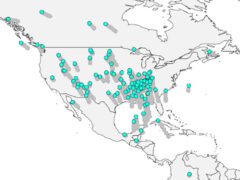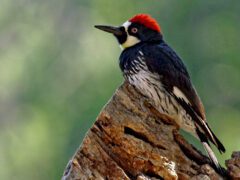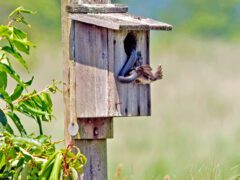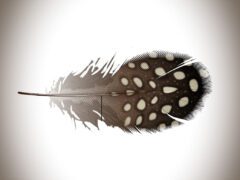The Four Keys to ID
- Size & Shape
These compact swallows have rounded, broad-based wings, a small head, and a medium-length, squared tail.
Relative Size
Smaller than a Purple Martin; slightly larger than a Bank Swallow.

 sparrow-sized or smaller
sparrow-sized or smallerMeasurements
- Both Sexes
- Length: 5.1 in (13 cm)
- Weight: 0.7-1.2 oz (19-34 g)
- Wingspan: 11.0-11.8 in (28-30 cm)
© Dorian Anderson / Macaulay Library
- Color Pattern
In poor light, Cliff Swallows look brownish with dark throats and white underparts. In good light you’ll see their metallic, dark-blue backs and pale, pumpkin-colored rumps. They have rich, brick-red faces and a bright buff-white forehead patch like a headlamp. Some juveniles show whitish throats in summer and fall.
© George Pagos / Macaulay Library - Behavior
Cliff Swallows zoom around in intricate aerial patterns to catch insects on the wing. When feeding in flocks with other species of swallows, they often stay higher in the air. They build mud nests in colonies on cliff ledges or under bridges, eaves, and culverts.
- Habitat
Cliff Swallows traditionally built their nests on vertical cliff faces. With the expansion of road infrastructure they have adopted many bridges, overpasses, and culverts as their colonial nesting sites. They feed in areas near and over water, frequently mixing with other species of swallows.
© wendy wright / Macaulay Library
Regional Differences
Most Cliff Swallows in North America have whitish foreheads; however, birds from the Mexican population (which extends into the southwest U.S.) have dark chestnut foreheads.











